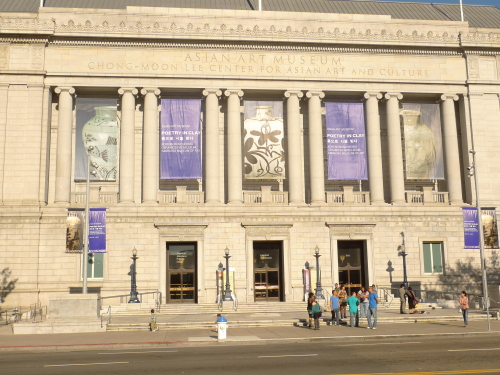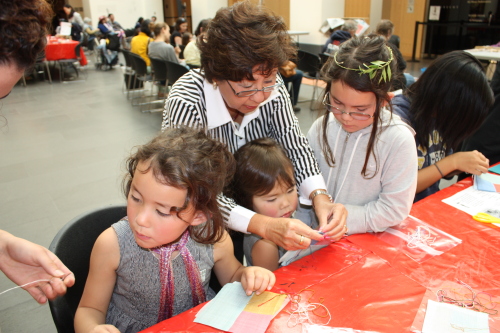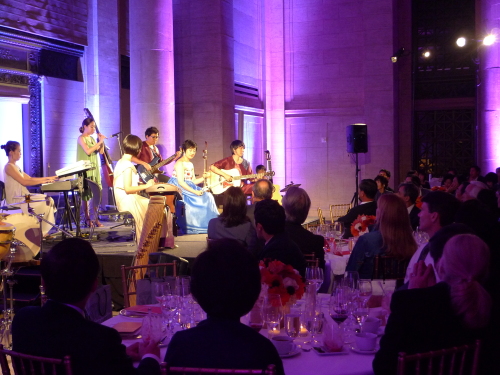Korean Culture Day celebrated at Asian Art Museum of San Francisco
SAN FRANCISCO -- Korean music, delicate traditional patchworks, exquisite Buncheong ceramics and hands-on artistic activities brought a wide range of people together in the Korean spirit in San Francisco on Saturday.
The Korea Foundation Korean Culture Day, a celebratory event of the opening of “Poetry in Clay: Korean Buncheong Ceramics from Leeum, Samsung Museum of Art” at Asian Art Museum of San Francisco, was filled with diverse programs that celebrated Korean culture and art. The museum offered free admission to visitors for the day.
The event was sponsored by the Korea Foundation, which celebrates its 20th anniversary this year. The organization has been promoting Korean culture and study programs around the globe, since its establishment in 1991.
The Buncheong exhibition features some 60 ceramics in the buncheong style -- a form of Korean stoneware with a distinctive bluish-green tone -- that flourished in the 15th and 16th century Korea.
 |
The frontview of Asian Art Museum of San Francisco property, where the banners of its current Korean exhibition, “Poetry in Clay: Korean Buncheong Ceramics from Leeum, Samsung Museum of Art,” is displayed. (Korea Foundation) |
The same exhibition was previously held at the Metropolitan Museum of Art in New York from April 7 to Aug. 14. The exhibition in San Francisco, unlike the one in New York, also exclusively features works of Korean contemporary artists, who have been inspired by the buncheong aesthetic and its traditional artistic approach. The featured artists include Koo Bohn-chang, Shin Mee-kyoung, Yee Soo-kyung and Ha In-sun.
“It’s interesting to see how the contemporary artists have been influenced by the Korean tradition, mixed with their present-day perspective and a sense of reality,” said Kim Hyon-jeong, the associate curator of Korean art at the museum. “And we’d like our visitors to see Korea’s past through the works of these artists in return.”
Artist Shin Mee-kyoung, whose “ceramics” are famous for being made of soap, was popular on Saturday with her soap-making workshop. Each participant was given a plastic cup, and was asked to put in anything they wanted – colorful fabrics, ribbons, feathers, or stones. Then the artist then poured hot liquid soap into each person’s cup with the decorative items, which would harden into a piece of solid soap once cooled down.
The room was completely packed throughout the day, and most of the participants were children. Catharina Min, a Korean-American mother who brought her two daughters -- Isabella, seven, and Sydney, six -- to the workshop, said such cultural events were very important for her children.
“I absolutely love it,” she told The Korea Herald. “I moved to the States when I was 12, and worked in Korea from 1994 to 1998. During my stay in Seoul I was so happy that I could still speak the language and really connect to its culture. My kids have been going to Korean school for three years now, and I want to make sure they learn about Korea.”
Artist Shin started creating soap artifacts when she moved to London from Seoul in 1995.
“I saw a piece of white stone displayed at a British museum and thought it looked like a piece of soap,” Shin told The Korea Herald. “And I felt such notion of mine came from my experience being a foreigner in the city. So I started to recreate the ancient ceramic relics of both the East and the West, using soap as the main material. As soap is something that easily wears out and disappears quickly, I wanted to shorten the gap between the West and East, and the present and the past.”
One of Shin’s soap projects consisted of making of small-sized Buddha sculptures, and placing them in public bathrooms so people could actually use them when washing their hands. When each of the soap Buddhas is worn out, Shin would bring them to an exhibition hall and display them as contemporary relics that have been very quickly and deeply affected by the passage of time. “Shin’s works really speak for immigrant diaspora,” said Linda Inson Choy, an independent art curator who had an open art discussion with Shin on Sunday at the museum.
“We (immigrants) kind of have to adapt to wherever we are. And making of Buddha in such cleansing medium is very poetic, as Buddha’s teaching is all about letting things go, and not having too many attachments in life. It’s almost a Zen approach to do something like that.”
Ceramist Lee Kang-hyo, on the other hand, demonstrated Korea’s ancient method of pottery making using a simple kick-wheel. The artistic demonstration attracted both children and grown-ups, as his simple technique quickly turned a mere lump of clay into a giant pot as if by magic. Young children were given an opportunity to participate in Lee’s demonstration, touching the wet clay and making fingerprints with him.
“Creating of Korean Onggi -- ethnic earthenware -- is considered as one of the fastest pottery-making techniques in world history,” Lee told The Korea Herald. “And because it can be made in such a short time, it is perfect for artistic demonstrations for non-Koreans who live in foreign countries. I’ve always received positive responses whenever I performed such demonstrations overseas, and today is especially more meaningful because what I do complements the Buncheong exhibition.”
Mindy Solomon, Lee’s art dealer in the U.S., said his works are extremely iconic, as he mixes the traditional form of Korean pottery in a very expressive and even contemporary way.
“There is so much expressiveness,” Solomon said.
“And there’s real surface dialogue going on, the way his finger marks and moves with the lines.”
Solomon also said Lee’s artistic demonstrations could bring a new perspective of pottery art, especially for those who own Korean pots like herself.
“Most home owners of pots look at works in the context of ‘where am I going to put it?’” she said.
“But then you come to realize (after seeing the demonstration) they are also sculptures.”
 |
Mary Kim (center), a volunteer of Asian Art Museum of San Francisco, teaches young visitors how to make a piece of “bojagi,” traditional Korean patchwork, Saturday. (Claire Lee/The Korea Herald) |
On the other side of the room, artist Lee Young-min held a class to make bojagi -- Korea’s traditional textile work. Lee, who has been living in the Bay area for about 15 years, has taught at the San Francisco museum on several occasions.
“I think it’s the philosophy that’s behind the bojagi making that really attracts the people here,” Lee said.
“The frugal spirit that you’d use the left over cloths and patch them together to make one piece of bojagi, and the well-wish you put into it when you make it for someone.”
For Mary Kim, a long-time volunteer of the museum, the event was a thrilling experience.
“We’ve always had a celebration around the Chuseok season, but it has never been this big,” Kim said, while helping Lee with her bojagi workshop.
“It’s such a joyous occasion. But I’d like to see more Korean related items at the gift store.”
Next to the artistic demonstrations, a small exhibition hall was filled with Korean-themed artworks. Students at Oakland Korean School in California, created the art pieces after spending two weeks together watching videos on Korean history and reading Korean books. The paintings dealt with the Rose of Sharon, Korea’s national flower, the Joseon period’s most celebrated naval commander Yi Sun-sin and his warship “Geobukseon,” and the Korean War. One of the paintings, however, had three people wearing different national costumes, including hanbok and a Chinese garment.
“Most of our students belong to the third generation,” Jung Choong-sil, the principal of the Korean school, told The Korea Herald. “And many of them have a parent who is not Korean. So it is important for Korean cultural programs to engage multicultural context from now on.”
 |
Haegum Plus, a crossover musical group, performs at the evening gala of Korea Foundation Korean Culture Day at Asian Art Museum of San Francisco, Saturday. (Korea Foundation) |
Haegum Plus, a crossover musical group directed by Kang Eun-il, performed three times during the day, playing in their signature musical style which mixes Korean traditional music with western jazz and classical music. Kang led the group by playing her traditional Korean two-stringed instrument called haegeum, presenting more than seven pieces, including Korea’s folksong “Arirang,” and “Hey Ya,” a remake of Korean folksong “Ongheya.” The group received a standing ovation after their final performance of the day.
On Sunday, professor Kim Byung-jong, who currently teaches at the College of Fine Arts of Seoul National University, gave a special lecture at the Asian Art Museum, comparing the formative aesthetic of Korean art with distinctive characteristics of Asian art as a whole.
The exhibition, “Poetry in Clay: Korean Buncheong Ceramics from Leeum, Samsung Museum of Art” runs until Jan. 8 of next year at the Asian Art Museum of San Francisco.
By Claire Lee, Korea Herald Correspondent
(
dyc@heraldcorp.com)










